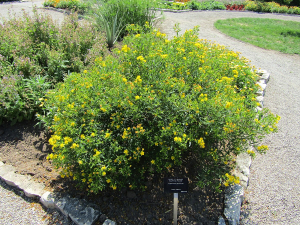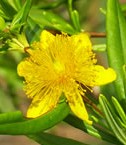 This native of eastern and central United States is a small compact deciduous shrub with medium texture and rounded form. It produces yellow flowers about one inch across with five petals and a mass of stamens that may partially hide the petals. The flowers are produced in summer for several weeks or more and are followed by brown seed capsules that persist into winter providing interest after the leaves have fallen. The dark green leaves are linear and about one to three inches long. The light brown bark of older stems is exfoliating to reveal the pale orange inner bark. Shrubby St. Johnswort is easy to grow and does well in a sunny site in average, well-drained soil but tolerates less and can be found growing naturally in open woods, meadows, and on steep banks. As a garden plant it is useful grouped in a shrub border, in a rock garden or as a low hedge. The genus name, Hypericum, is from the Greek word hypereidon and is derived from hyper, meaning above, plus eikon meaning picture. The plant was believed to keep evil spirits away and the flowers of some species were placed above pictures to ward off evil at the ancient midsummer festival on June 24 which later became he feast of St. John. In revenge the Devil pierced holes in leaves of some species with a needle. Photo Credit Leonora (Ellie) Enking, Wikimedia Commons
This native of eastern and central United States is a small compact deciduous shrub with medium texture and rounded form. It produces yellow flowers about one inch across with five petals and a mass of stamens that may partially hide the petals. The flowers are produced in summer for several weeks or more and are followed by brown seed capsules that persist into winter providing interest after the leaves have fallen. The dark green leaves are linear and about one to three inches long. The light brown bark of older stems is exfoliating to reveal the pale orange inner bark. Shrubby St. Johnswort is easy to grow and does well in a sunny site in average, well-drained soil but tolerates less and can be found growing naturally in open woods, meadows, and on steep banks. As a garden plant it is useful grouped in a shrub border, in a rock garden or as a low hedge. The genus name, Hypericum, is from the Greek word hypereidon and is derived from hyper, meaning above, plus eikon meaning picture. The plant was believed to keep evil spirits away and the flowers of some species were placed above pictures to ward off evil at the ancient midsummer festival on June 24 which later became he feast of St. John. In revenge the Devil pierced holes in leaves of some species with a needle. Photo Credit Leonora (Ellie) Enking, Wikimedia Commons
Type: Flowering deciduous shrub
 Outstanding Feature: Flowers
Outstanding Feature: Flowers
Form: Compact, dense, rounded
Growth Rate: Slow to medium
Bloom: Yellow flowers l” across are produced singly or in clusters for a long bloom time in summer; five petals, abundant sepals.
Size: 1-5’ H x 14’ W
Light: Full sun to partial shade
Soil: Average, well-drained, pH adaptable; moderately drought tolerant
Hardiness: Zones 4-9
Care: Low maintenance; prune after flowering if desired.
Pests and Diseases: Generally disease and pest free but can succumb to root rot and wilt and in hot humid conditions.
Propagation: Seed; soft-wood cuttings.
